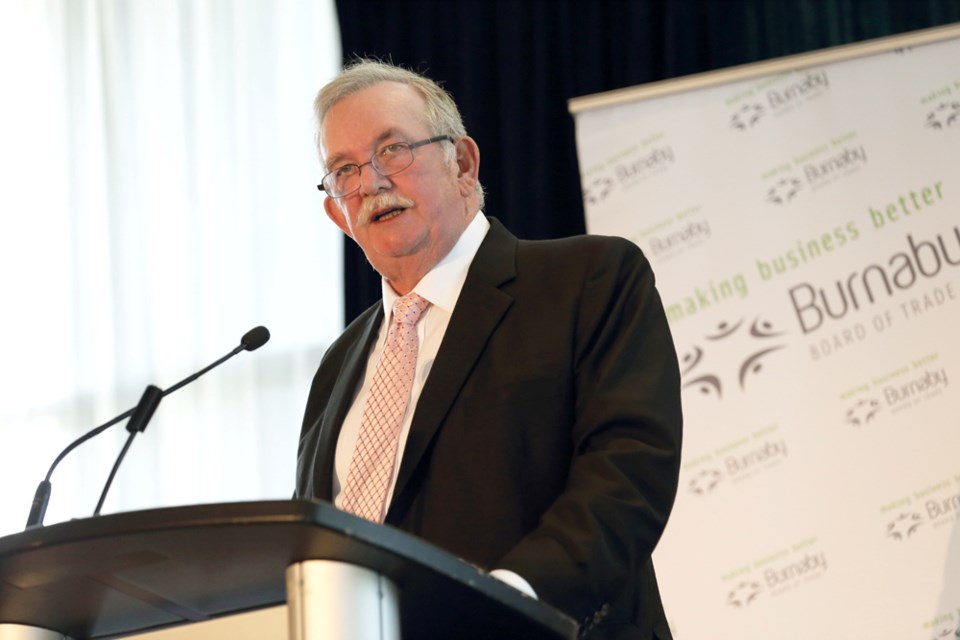Growth and development once again dominated Mayor Derek Corrigan’s speech during the annual state of the city address on Thursday.
Burnaby’s business community got to listen in on what kind of projects are happening around town and what staff have planned for the future at the event, hosted by the Burnaby Board of Trade.
“Our development of complete communities is primarily happening in our four town centres, as set out in our city’s plans more than 20 years ago,” Corrigan told the crowd. “Where we’re creating opportunities for high-density buildings and, at the same time, adding the kinds of services that are viable when there is sufficient population to support them.”
Development in Burnaby remained “robust,” noted the mayor, with the city handing out nearly $820 million worth of building permits in 2016, compared to $879 million in 2015, the highest in the city’s history.
All that development has given staff, through the Community Benefit Bonus Policy, a chance to get the ball rolling on more projects, Corrigan told the NOW after the event.
The policy allows additional densities within the four town centres. Twenty per cent of contributions go into a housing fund to support housing-related projects, while the remaining 80 per cent goes towards community amenities such as parks and pools.
“We’re at a stage where that wealth we’ve created is being transferred into those kinds of options,” he said, pointing to the construction of 276 units of transitional, non-market and seniors’ rental housing, and the $8.5 million the city is investing in building 181 non-market family and seniors’ units in the Edmonds Town Centre’s Southgate neighbourhood.
Corrigan also brought up council’s decision to help the Burnaby Association for Community Inclusion (BACI) by giving the organization $1.6 million of bonus density money. The money subsidizes the land and servicing costs for 42 years, allowing BACI to go forward with its plans to build 15 non-market housing units for people with developmental disabilities.
The mayor also noted more than 1,500 new purpose-built market rental units and more than 4,000 secondary rental units (including secondary suites) are under construction or in the rezoning process.
But some groups, like Alliance Against Displacement, have criticized the city’s pace of development, arguing highrise towers are depleting the municipality’s affordable rental stock and forcing people to move.
Corrigan said it’s a reality for all Metro Vancouver cities.
“There isn’t a mayor in the region that isn’t dealing with the same issue. The price of land and the limited amount of land available in the Lower Mainland is causing everyone to reach the point of unaffordability.
“As long as you’re getting 35,000 to 40,000 people a year, somebody has to accept that growth. If we start spreading out into the agricultural land in the valley, we’re going to lose big assets. Our view has been let’s move them really close to transit in dense developments,” he explained.
BRENTWOOD
*The redevelopment of Brentwood mall will feature a new community centre and 300 new purpose-built rental units.
*Construction of Willingdon Linear Park will start this year and will open in 2018.
*The Gilmore Station Master Plan will result in 2,100 retail and 5,100 office jobs, turning the low-density commercial area into one that’s integrated with the SkyTrain station.
LOUGHEED
*The Lougheed Core Area Conceptional Master Plan: rezoning development applications for Phase 1 include more than 150,000 square feet of commercial space and more than 1,500 apartment units; in addition, a rezoning application for 645 new purpose-built rental units on the Lougheed Village site has been submitted.
EDMONDS
*The Southgate Neighbourhood Master Plan will transform the industrial site into a neighbourhood with a public park, and will include 600,000 square feet of alternative housing density allocated for non-market and co-op housing.
METROTOWN
*A final draft of the Metrotown Development Plan Update will be presented to council this summer (the mayor has told the NOW he expects it by June).



